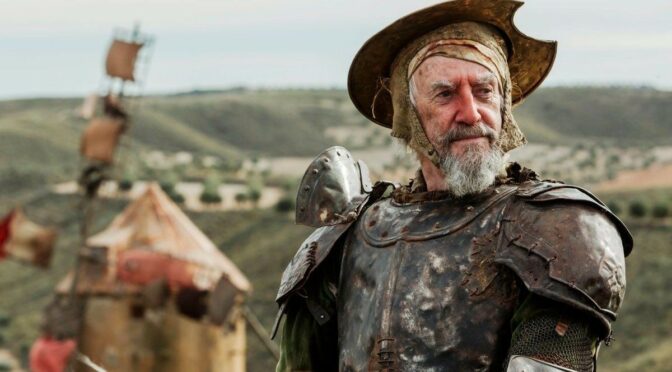The completion of THE MAN WHO KILLED DON QUIXOTE represents the culmination of a fittingly Picaresque quest, as Terry Gilliam attempts to finally find Quixote after nearly 30 years of production stagnation and setbacks.
Jonathan Pryce is perfectly cast as Quixote, embodying the old man with a combination of sincerity, childlike exuberance and commitment to his beliefs that brings genuine pathos to his delusional condition. Adam Driver is entertainingly baffled as film producer Toby, the unwilling Sancho Panza to Pryce’s Quixote. His best moments are in the self-destructive slapstick quest sequences (Driver is a revelation as a physical comedian) and a particular highlight is his attempt to mislead Don Quixote with a magnificent song and dance impression of 1930s comedian Eddie Cantor.
Nonetheless, his character’s journey feels somewhat less convincing as he starts to emulate some of the more chivalric and less self-serving traits of Quixote. This seems to be the only direction his character could move in – a comment made early on in the film – “We become what we hold onto” – becomes a prophecy as his desire to protect Joana Ribeiro’s Angelica marks the beginning of his transformation.
On that note, it has to be said that the female representation is not one of the film’s strengths. At their most archetypal, Angelica (clue in the name) is the innocent whose seduction under Toby’s lens earlier in her life leads her to a path of prostitution, while Olga Kurylenko’s Jacqui is a one-dimensional wanton seductress, determined to bed Toby and get him in trouble with her husband Stellan Skarsgård, ‘The Boss’.
Gilliam has packed the film full with ideas and comments, and at times it becomes difficult to understand exactly what he is trying to say. A non-exhaustive list includes: the danger of callously reappropriating another culture’s legend, authenticity versus artifice, the power of imagination, loss of innocence and the dreams of youth, fantasy versus reality – these are all interesting threads but they become jumbled and several of them are left hanging loose by the film’s conclusion.
THE MAN WHO KILLED DON QUIXOTE is a bombastic, colourful and appealing adventure peppered with just enough outlandish moments to keep Gilliam fans happy, while the film’s central comment about the enduring appeal of legend means the story of Don Quixote continues to live for a new audience.


As one watched, it was as if Gilliam were not going to deny the kinship that derived from melding Herzog’s Fitzcarraldo (1982) with its ‘making of’ (in Les Blank’s Burden of Dreams (1982)), but also not tacitly acknowledge the likeness :
1. A film where Klaus Kinski substituted for Mick Jagger (when Fame called the latter away), and so scenes had to be re-shot
2. Where the real-life ‘problems’ (well, people died) of what Kinski seeks to do as Fitzcarraldo (a name that itself is just a corruption of the real name of Fitzgerald) threatened the film’s making
3. Where the victory that Fitzcarraldo defiantly does achieve proves, in practical terms, to be short lived – and, yet, he still ends up victorious (on other terms)